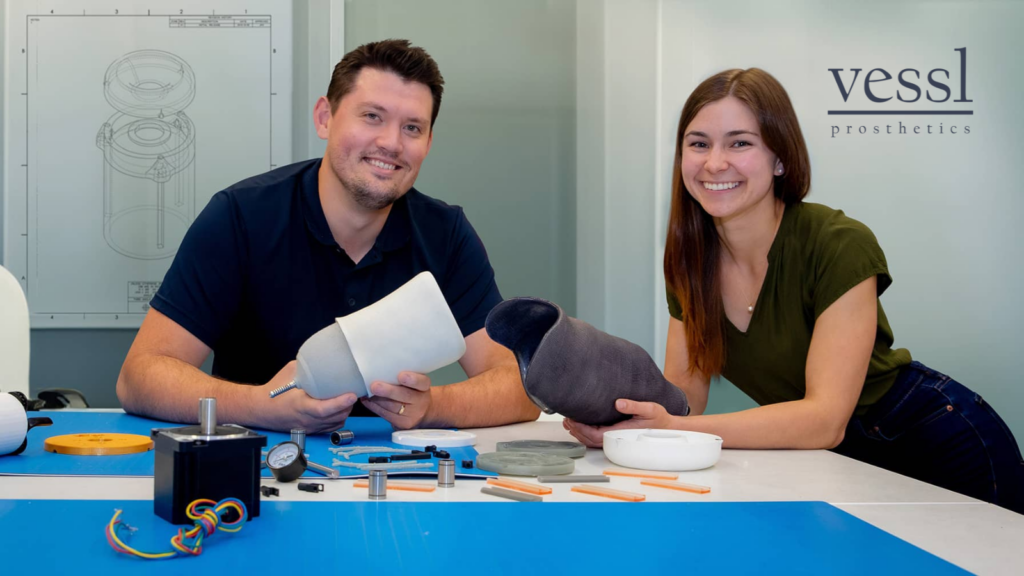Home » A device long in need of a solution
A device long in need of a solution

One day in the biomedical centre at Western University, Sydney Robinson and Oleksiy Zaika shadowed a doctor who was an expert in Diabetes, the leading cause of leg amputation. Consequently, he was also familiar with the everyday struggles that many of his patients faced with the sockets of their prosthetics.
A painful problem
Because prosthesis users’ limbs constantly change size for various reasons, constant socket adjustment is required. A leg that was amputated at the knee, for example, can grow or shrink in size because of fluctuations in weight, height, temperature, humidity, and wear. This can lead to chaffing and rubbing, irritation, and pain. Those wearing a prosthesis must make changes throughout the day to reduce painful wear.
Poor existing technology
Before Sydney and Oleksiy launched Vessl, there were two options. For those with an amputation below the knee, there was a static socket that didn’t change size. A user would inconveniently take their leg off and put sock on if their leg had shrunk.
For those with an amputation above the knee and a static socket, whenever they needed to make an adjustment, they had to take their pants off. When out in public, they had to find a private space to change. This is not easy for many amputees, especially those part of the aging or Diabetic population.
In addition, leg changes aren’t always noticeable. Since the bottom of an amputated leg, the residuum, is sensitive and contains muscle around bone, pressure can be painful. A uniform pressure is desired, but that’s nearly impossible with a static socket. When a leg shrinks, bottoming out occurs and pressure mounts on the residuum. Even though the static socket is a counterintuitive technology, it is used by 90% of the US market and 95% in Canada.
Newer tech, similar problem
About a decade ago, new technology became available. A twist dial was incorporated into prostheses that allowed the user to make changes. But if a user has poor dexterity, the dial is hard to adjust. Furthermore, it is still not always detectable if tightening or loosening is required. Overtightening causes pain, and if the device is too loose, a user may get issues with their balance.
Robinson and Zaika focused on developing an auto-adjusting socket.
Vessl creates auto-adjustment
Robinson and Zaika pioneered a passive, auto-adjusting socket for prostheses. An amputee wouldn’t have to know how much to tighten or loosen the socket connecting their leg to the prosthesis. By establishing a consistent level of tension within the device, a prosthesis would always fit.
The new device doesn’t contain sensors, batteries, or motors, either, which would add weight and bulk, not to mention the need to change batteries or fix any motors or sensors.
At the bottom of Vessl’s socket is a shock-absorbing mechanical disc. It turns internally, connected to cables that are linked with the cutout panels of the socket’s internal mechanism that pulls on the cables, which then pull the panels in.
By maintaining a set level of tension and allowing vertical displacement, the socket dynamically and automatically achieves the set tension on a shrinking leg and vice versa.
The socket also includes a manual tension release button when sitting down.
TechAlliance assists with product development
Through a Medical Innovation Fellowship, Robinson and Zaika connected with TechAlliance to assist with a go-to-market strategy and provide general startup advice and recommendations.
On June 21, 2022, Vessl incorporated.
The TechAlliance team worked collectively to provide guidance that ensured Vessl continued innovating. They still consistently engage with them at different networking events and have connected them with other founders. They have also linked Robison and Zaika with MP Peter Fragiskatos and investors.
The i.d.e.a. Fund™
Dr. Martin Smith, Venture Growth Advisor at TechAlliance then steered Robinson and Zaika then applied to the i.d.e.a. Fund™. As a startup company displaying significant product acceleration and a female co-founder, Vessl easily qualified for the funding. The funding enabled the team to iterate Vessl prototypes quicker and use higher-quality materials and parts. After thorough testing, they created a demo leg that they put into their socket to accurately simulate the hourly changes a leg can undergo.
Vessl is a recent i.d.e.a. Fund™ recipient. Supported by a $10-million Government of Canada investment, through the Federal Economic Development Agency for Southern Ontario (FedDev Ontario). It is led by Boundless Accelerator (previously Innovation Guelph) in partnership with five Regional Innovation Centres (RICs): WEtechAlliance, Haltech, Innovate Niagara, Innovation Factory and TechAlliance of Southwestern Ontario. The program helps high-potential ventures access the tools they need to succeed by providing financial and business advisory supports to develop or redesign products, services, processes and technologies that reduce impacts on the environment and create made-in-Canada solutions.
The Vessl team also maintain an environmental focus, using 3D printing in addition to higher quality products that reduce environmental impact, and the total number of sockets amputees need throughout their lifetime.
What’s next?
Vessl has lined up seven U.S. clinics and six Veterans Affairs centers to provide feedback.
The new technology that Vessl is pioneering will provide a much-needed option for those currently living with the challenges of existing prosthesis technology. It will change the lives of many for the better!
Christina Fox, CEO of TechAlliance
To learn more about Vessl visit https://vesslpro.com/
To learn more about the i.d.e.a. Fund™ go to https://www.techalliance.ca/i-d-e-a-fund/
To learn more about FedDev Ontario go to https://feddev-ontario.canada.ca/en
TechAlliance
https://techalliance.ca
We are the place for dreamers, innovators, and world-changing ideas. We create an entrepreneurial culture, launch new startups, and accelerate growth for established tech companies, while attracting the next generation of tech talent and innovative entrepreneurs. We connect people and empower talent in Southwestern Ontario. We engineer, level up, catalyze, discover and accelerate our region’s innovation economy.

